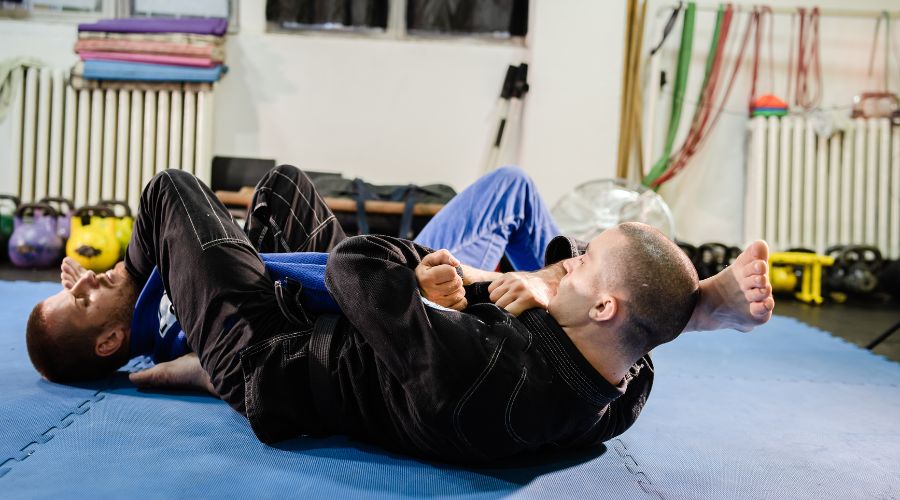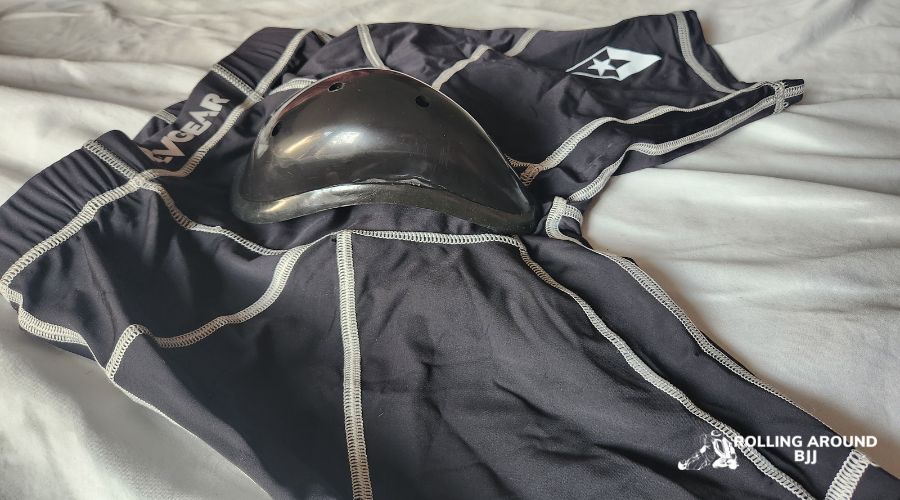One of the beautiful things about BJJ is that the nature of training means we can get by with very little protective equipment compared to MMA guys and strikers. Aside from a mouthguard, everything else is optional, but the groin cup can bring conflicting opinions. So do you wear a cup in BJJ?
In general, you do not wear a groin cup in BJJ. It’s not allowed in most competitions because it can be dangerous for the opponent and provide an unfair advantage through a stable fulcrum point or even a weapon to apply pain and pressure with. For these reasons, it’s rarely used in training unless you have a preexisting injury.
This short statement provides most of the information about cups in BJJ, but there is a lot more to be said about each point in addition to the few situations where using a cup is recommended.
Should You Wear A Cup In BJJ?
The protective groin cup is a godsend for fighters in all striking disciplines and athletes from various sports like cycling, rugby, football, etc. But for BJJ, this protective piece is usually neither required nor recommended. Whether you wear a cup or not is typically personal, but some academies may not allow them during free rolling.
Here are a few reasons why you shouldn’t wear a cup while training in BJJ and why most grapplers don’t use one.
It Can Hurt Your Training Partners
One of the main reasons BJJ guys don’t wear a groin protector is that it can hurt training partners. Despite the good designs, the cup is still a piece of plastic that can scrape or hit someone during rolls. Then the danger becomes much more significant in positions like north-south, where your partner’s head will be between your thighs, and the cup has a real chance of hitting him in the face.
Admittedly, the risk of injury is insignificant, but it’s still unnecessary when considering all the other drawbacks of cups.
It Provides an Advantage

The main reason cups are banned from most competitions is they provide an unfair advantage in certain positions. Notably, they aid a lot in armbar attempts. The cup provides an excellent fulcrum point, greatly enhancing your leverage and reducing the required force to finish the submission.
In this way, the cup provides an artificial aid that would otherwise be impossible. You won’t be able to compete with a cup anyway, so using the fulcrum of the cup for armbars and other moves in training will also create bad habits that will play a negative role in competition.
A cup can also be used in other ways to provide an advantage. For example, it can serve as a spike to drive against an opponent’s body part, like the ribs from mount or the spine from back control.
It Restricts Movement
Modern protective cups are well-designed with minimum inhibition of movement and maximum possible comfort. But there is still a piece of plastic on your grоin which can become uncomfortable in certain situations.
BJJ involves getting into weird positions, and the cup is bound to be uncomfortable in some of them. Consider trying to shrimp from underneath someone or in similar positions where the cup can produce quite an unpleasant feeling.
You Don’t Need Need A Cup
Another reason a protective cup is not so useful for BJJ once you have some experience is that you understand space better and become sensitive enough when there is a danger to this most valuable of areas.
Of course, accidents happen, but generally, the danger is relatively low because it’s just another small thing you worry about when rolling. Or, more simply, you become better at protecting your delicate parts.
On top of that, most decent training partners quickly develop mindfulness about not hitting the other guy in the groin. After all, as men, we fully understand the danger, and I doubt many people are not careful in this regard.
Is It Legal To Wear A Cup In Competition?

The IBJJF is the leading BJJ organization, and it bans the use of groin protectors under all its rulesets because of the reasons above, like the danger of injury and the advantage it provides for certain submissions, mainly the armbar.
Most other organizations also prohibit cups, but if you plan to compete, it’s always best to familiarize yourself with the rules, not just about groin cups but in general.
The Advantages Of Wearing A Cup In Training
Groin cups are not all bad, though. They are a good piece of equipment mandatory for many sports. They can prevent nasty injuries and unpleasant episodes during overly aggressive knee slide passes and mad scrambles.
If you have an injury to the groin or family jewels but still want to grapple, by all means, use a cup. I am sure even if the academy does not allow the use of cups in general, which is a rarity, no one will stop you if you do it to prevent further aggravation of an injury.
Modern cups like the Diamond MMA cup come with compression shorts, and they are designed to solve all the issues with comfort, restricted movement, and displaced cups.
The issue that it can still be used as an advantage remains, but you will use it only in training anyway, so be mindful in positions where it can threaten the well-being of your training partners.
Another common reason you may want to get used to rolling with a cup is if you train for an MMA fight. In mixed martial arts, the cup is mandatory, and it is good to get used to the feeling of it, even during pure BJJ rolling.
You can follow this as a simple rule and start training with a cup a few weeks before your MMA match, or conversely, if you usually prepare with a cup but start training for a grappling-only contest, remove the protector a few weeks before the competition to get used to the feeling.
Other Protective Gear You Can Use
As I said in the opening paragraph, jiu-jitsu allows for much safer training at full power than most other combat sports. This is why protective gear, including groin cups, is usually unnecessary, but some equipment can help.
The mouthguard is the main one, and it is mandatory for competitions, free rolling, and, in my opinion, even during drilling. The only downside of wearing a mouthguard is slightly blurred speech, but it can save you from a costly trip to the dentist.
Additionally, knee and elbow pads are sometimes used if you have pain or injuries in these areas. Knee pads are convenient for wrestling-centric sessions focused on double-leg takedowns.
Another questionable piece of protective gear is headgear. It is not allowed in competition because it will get in the way of grappling, but a suitable BJJ headgear can be a workaround to training with freshly drained cauliflower ears.
Summary
Cups are rarely used in BJJ training and never in competitions because the potential risks outweigh the benefits. They are uncomfortable, increase the chance of injury, and can be used to gain an advantage. You can quickly gain self-awareness and move in a way to avoid as many dangers to the family jewels as possible.
With that said, cups do have a place in BJJ. They can help people avoid aggravating existing injuries and be mandatory for grapplers fighting in MMA or other rulesets involving flying limbs.
